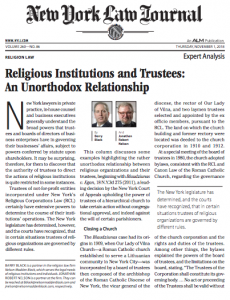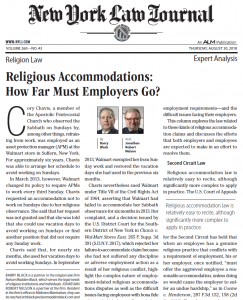Four justices of the U.S. Supreme Court – Justices Alito, Thomas, Gorsuch, and
Kavanaugh – have issued a statement that suggests that they are willing to reconsider a number
of past Supreme Court decisions with the goal of expanding the right of employees to exercise
their religion.
The justices’ statement came in a case from the U.S. Court of Appeals for the Ninth
Circuit, Kennedy v. Bremerton School District.
In this case, Joseph Kennedy, a high school football coach at Bremerton High School, a
public high school in Kitsap County, Washington, across the Puget Sound from Seattle, asserted
that he lost his job for engaging in conduct that was protected by the Free Speech Clause of the
First Amendment. He sought a preliminary injunction restoring him to his job and requiring the
school to allow him to pray silently on the 50-yard line after each football game.
The district court denied Kennedy’s motion for a preliminary injunction. It reasoned that
Kennedy “was still in charge. He was still on the job. He was still responsible for the conduct of
his students, his team. And a reasonable observer, in my judgment, would have seen him as a
coach, participating, in fact leading an orchestrated session of faith. . . .”
The Ninth Circuit affirmed the district court in a decision in which it recounted
Kennedy’s prayer-related activities over the course of several years, including conduct in which he engaged as a private citizen, such as praying in the stands as a fan after he had be suspended from his duties. Kennedy sought to have the Supreme Court review the Ninth Circuit’s decision, but the
Court declined to do so.
The four justices agreed that the Supreme Court should not review this particular case.
Their statement, however, suggests a desire to have the full Court revisit various past decisions
regarding the ability of employees to exercise their religion.
First, the justices said that the Ninth Circuit’s decision applied the Supreme Court’s
opinion in Garcetti v. Ceballos, 547 U. S. 410 (2006), to public school teachers and coaches “in
a highly tendentious way.” The justices observed that, according to the Ninth Circuit, public
school teachers and coaches could be fired if they engaged in any expression that the school did
not like while they were on duty, and that the Ninth Circuit appeared to regard teachers and
coaches as being on duty at all times from the moment they reported for work to the moment
they departed, provided that they were within the eyesight of students.
The justices said that the Court “certainly has never read Garcetti to go that far.” They
added that, under Garcetti, a public employer may regulate employee speech that was part of the
employee’s job duties, but that a public employer could “not convert private speech into public
speech” by creating “excessively broad job descriptions.”
The justices then impliedly criticized two other prior Supreme Court decisions for going
too far to limit the ability of employees to exercise their religion.
First, they referenced Employment Div., Dept. of Human Resources of Ore. v. Smith, 494
U. S. 872 (1990), where, they said, the Court “drastically cut back on the protection provided by the Free Exercise Clause.” The Court in that case ruled that application of a “neutral law of
general applicability” to religious conduct did not automatically violate the First Amendment.
The justices also cited Trans World Airlines, Inc. v. Hardison, 432 U. S. 63 (1977),
where the Court opined that Title VII’s prohibition of discrimination on the basis of religion did
not require an employer to make any accommodation that imposed “more than a de minimis
burden.”
Justices Alito, Thomas, Gorsuch, and Kavanaugh concluded their statement by noting
that the Court had “not been asked to revisit those decisions.”
It may not be too long now before the Court is specifically asked to do just that.


